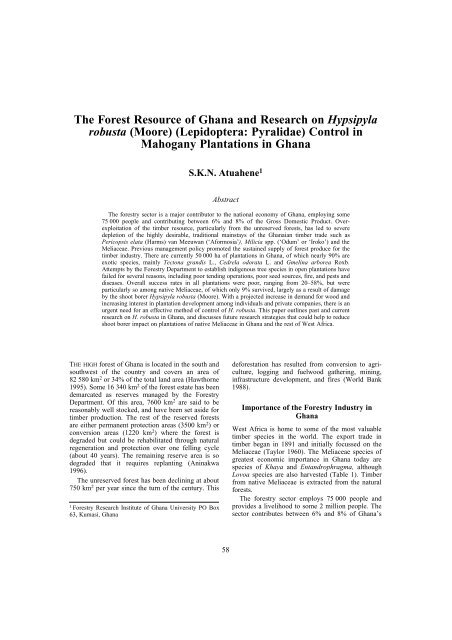Hypsipyla Shoot Borers of Meliaceae in Sri Lanka - Australian ...
Hypsipyla Shoot Borers of Meliaceae in Sri Lanka - Australian ...
Hypsipyla Shoot Borers of Meliaceae in Sri Lanka - Australian ...
You also want an ePaper? Increase the reach of your titles
YUMPU automatically turns print PDFs into web optimized ePapers that Google loves.
The Forest Resource <strong>of</strong> Ghana and Research on <strong>Hypsipyla</strong><br />
robusta (Moore) (Lepidoptera: Pyralidae) Control <strong>in</strong><br />
Mahogany Plantations <strong>in</strong> Ghana<br />
S.K.N. Atuahene 1<br />
Abstract<br />
The forestry sector is a major contributor to the national economy <strong>of</strong> Ghana, employ<strong>in</strong>g some<br />
75 000 people and contribut<strong>in</strong>g between 6% and 8% <strong>of</strong> the Gross Domestic Product. Overexploitation<br />
<strong>of</strong> the timber resource, particularly from the unreserved forests, has led to severe<br />
depletion <strong>of</strong> the highly desirable, traditional ma<strong>in</strong>stays <strong>of</strong> the Ghanaian timber trade such as<br />
Pericopsis elata (Harms) van Meeuwan (‘Aformosia’), Milicia spp. (‘Odum’ or ‘Iroko’) and the<br />
<strong>Meliaceae</strong>. Previous management policy promoted the susta<strong>in</strong>ed supply <strong>of</strong> forest produce for the<br />
timber <strong>in</strong>dustry. There are currently 50 000 ha <strong>of</strong> plantations <strong>in</strong> Ghana, <strong>of</strong> which nearly 90% are<br />
exotic species, ma<strong>in</strong>ly Tectona grandis L., Cedrela odorata L. and Gmel<strong>in</strong>a arborea Roxb.<br />
Attempts by the Forestry Department to establish <strong>in</strong>digenous tree species <strong>in</strong> open plantations have<br />
failed for several reasons, <strong>in</strong>clud<strong>in</strong>g poor tend<strong>in</strong>g operations, poor seed sources, fire, and pests and<br />
diseases. Overall success rates <strong>in</strong> all plantations were poor, rang<strong>in</strong>g from 20–58%, but were<br />
particularly so among native <strong>Meliaceae</strong>, <strong>of</strong> which only 9% survived, largely as a result <strong>of</strong> damage<br />
by the shoot borer <strong>Hypsipyla</strong> robusta (Moore). With a projected <strong>in</strong>crease <strong>in</strong> demand for wood and<br />
<strong>in</strong>creas<strong>in</strong>g <strong>in</strong>terest <strong>in</strong> plantation development among <strong>in</strong>dividuals and private companies, there is an<br />
urgent need for an effective method <strong>of</strong> control <strong>of</strong> H. robusta. This paper outl<strong>in</strong>es past and current<br />
research on H. robusta <strong>in</strong> Ghana, and discusses future research strategies that could help to reduce<br />
shoot borer impact on plantations <strong>of</strong> native <strong>Meliaceae</strong> <strong>in</strong> Ghana and the rest <strong>of</strong> West Africa.<br />
THE HIGH forest <strong>of</strong> Ghana is located <strong>in</strong> the south and<br />
southwest <strong>of</strong> the country and covers an area <strong>of</strong><br />
82 580 km 2 or 34% <strong>of</strong> the total land area (Hawthorne<br />
1995). Some 16 340 km 2 <strong>of</strong> the forest estate has been<br />
demarcated as reserves managed by the Forestry<br />
Department. Of this area, 7600 km 2 are said to be<br />
reasonably well stocked, and have been set aside for<br />
timber production. The rest <strong>of</strong> the reserved forests<br />
are either permanent protection areas (3500 km 2 ) or<br />
conversion areas (1220 km 2 ) where the forest is<br />
degraded but could be rehabilitated through natural<br />
regeneration and protection over one fell<strong>in</strong>g cycle<br />
(about 40 years). The rema<strong>in</strong><strong>in</strong>g reserve area is so<br />
degraded that it requires replant<strong>in</strong>g (An<strong>in</strong>akwa<br />
1996).<br />
The unreserved forest has been decl<strong>in</strong><strong>in</strong>g at about<br />
750 km 2 per year s<strong>in</strong>ce the turn <strong>of</strong> the century. This<br />
1 Forestry Research Institute <strong>of</strong> Ghana University PO Box<br />
63, Kumasi, Ghana<br />
58<br />
deforestation has resulted from conversion to agriculture,<br />
logg<strong>in</strong>g and fuelwood gather<strong>in</strong>g, m<strong>in</strong><strong>in</strong>g,<br />
<strong>in</strong>frastructure development, and fires (World Bank<br />
1988).<br />
Importance <strong>of</strong> the Forestry Industry <strong>in</strong><br />
Ghana<br />
West Africa is home to some <strong>of</strong> the most valuable<br />
timber species <strong>in</strong> the world. The export trade <strong>in</strong><br />
timber began <strong>in</strong> 1891 and <strong>in</strong>itially focussed on the<br />
<strong>Meliaceae</strong> (Taylor 1960). The <strong>Meliaceae</strong> species <strong>of</strong><br />
greatest economic importance <strong>in</strong> Ghana today are<br />
species <strong>of</strong> Khaya and Entandrophragma, although<br />
Lovoa species are also harvested (Table 1). Timber<br />
from native <strong>Meliaceae</strong> is extracted from the natural<br />
forests.<br />
The forestry sector employs 75 000 people and<br />
provides a livelihood to some 2 million people. The<br />
sector contributes between 6% and 8% <strong>of</strong> Ghana’s

















